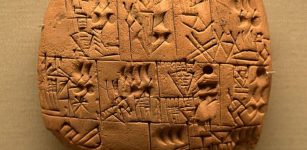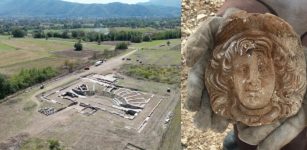Hades – Land Of The Dead In Greek Beliefs Offered Punishment And Paradise Full Of Harmony
A. Sutherland - AncientPages.com - In Greek mythology, there is a well-known myth of Hades, a harsh, shadowy place where the dead lived. Hades is also the name of the god who reigned over this inhospitable realm.
Hades does not resemble the Christian hell and cannot be compared to Irkalla, the ancient Mesopotamian underworld, or Mictlan in Aztec beliefs.
 Cerberus guarded the underworld, the realm of God Hades. Credit: Stock photo
Cerberus guarded the underworld, the realm of God Hades. Credit: Stock photo
The Greek realm of the dead is also very far from the reality of Diyu and its 18 levels of hell with awful chambers where people are tortured and constantly suffer pain.
The deceased entered Hades with the help of Charon, the ferryman and a psychopomp of Hades whose duty was to carry dead souls across the rivers Acheron and Styx that divided the world of the living from the world of the dead. It happened that also Hermes, the god, and a psychopomp, led the spirits of the dead to the afterlife; in Egyptian beliefs, this role had Anubis, the god of death, mummification, embalming, and the afterlife.
The underworld of Hades had five magical rivers. Each of them had its symbolic meaning: Phlegethon (fire), Lethe (oblivion), Acheron (the river of sorrow or grief), Cocytus (lamentation), and Styx (hate), the principal river in the underworld, which formed the boundary between the upper and lower worlds. The Greek gods swore upon the river Styx. Their oath was sacred, and if any deity was guilty of breaking it, he was deprived of divine drink (nectar) and ambrosia, which the gods traditionally consumed during their banquets.
The far side of the river was guarded by Cerberus, the three-headed dog, defeated by Heracles (Roman Hercules). Passing beyond Cerberus, the shades of the departed entered the land of the dead to be judged.
Then, the souls passed the entrance guarded by Cerberus, the three-headed dog was usually kind when the deceased had just arrived, but he became very aggressive when someone tried to get out.
Finally, they entered the realm of Hades and appeared before the judges (past kings and sons of Zeus) who passed verdicts on the dead. They weighed the mistakes and good deeds of souls, and the deceased was rewarded or cursed.
The painting depicts Aeneas' journey in the Underworld led by the Cumaean Sibyl (Aeneid VI, 269-282). Credit: Public Domain
If someone was once a brave hero or a good ruler, the judges sent them to the Elysian Fields (Elysium). In Greek beliefs, it was a part of Hades, destined for souls of good people who can enjoy feasts and celebrations, and can be compared to Valhalla in Norse mythology.
Those souls, who had committed serious crimes against the gods, would be sent to the Fields of Punishment, a part of Tartarus, where the dead, like a giant Tityos, Sisyphus, and Tantalus, were judged to spend eternity.
Zeus sent many of the Titans to Tartarus.
Asphodel Meadows was a peaceful and pleasant place in Hades for most souls who had not achieved any extraordinary deeds nor committed evil things.
Only a Few Mortals Could Leave Hades
Very few mortals could leave Hades once they entered, but as in all Greek mythology, there were exceptions to the rule. One example was Orpheus, a son of the Thracian river god Oiagros and the Muse Calliope. He was one of the few Greek heroes who visited the land of the dead and successfully returned to earth.
Hades had many residents, including also those who were not prisoners like, for example, Hekate, the goddess of magic, many evil spirits, and demons, including the Arai, the hearts of a curse, and the three Furies, goddesses of revenge and retribution, with appearance, which was both remarkable and hideous.
Hades, who ruled over his realm, did not like unwanted visitors; he played evil tricks on visitors from the land of the living, and trespassing on the land of the dead wasn’t welcomed.
Written by - A. Sutherland - AncientPages.com Senior Staff Writer
Updated on January 06, 2023
Copyright © AncientPages.com All rights reserved. This material may not be published, broadcast, rewritten or redistributed in whole or part without the express written permission of AncientPages.com
More From Ancient Pages
-
 Great Flood Myth Told By Klallam People Of Washington’s Olympic Peninsula – Confirmed
Archaeology | May 17, 2019
Great Flood Myth Told By Klallam People Of Washington’s Olympic Peninsula – Confirmed
Archaeology | May 17, 2019 -
 Uruk – Home To The Legendary Hero Gilgamesh
Featured Stories | Jun 6, 2021
Uruk – Home To The Legendary Hero Gilgamesh
Featured Stories | Jun 6, 2021 -
 Ancient Secrets Of The Masters Of Mu – Keepers Of Sacred Knowledge – Part 2
Featured Stories | Aug 25, 2018
Ancient Secrets Of The Masters Of Mu – Keepers Of Sacred Knowledge – Part 2
Featured Stories | Aug 25, 2018 -
 Travel Back To Ancient Greece In Virtual Reality
Archaeology | Jul 5, 2023
Travel Back To Ancient Greece In Virtual Reality
Archaeology | Jul 5, 2023 -
 Stunning 3,400-Year-Old Palace Of the Kingdom Of Mitanni Discovered Thanks To Drought
Archaeology | Jun 27, 2019
Stunning 3,400-Year-Old Palace Of the Kingdom Of Mitanni Discovered Thanks To Drought
Archaeology | Jun 27, 2019 -
 Puzzling Case Of An Ancient French Giant Whose Bones Caused Sensation And Controversy
Featured Stories | Jan 22, 2019
Puzzling Case Of An Ancient French Giant Whose Bones Caused Sensation And Controversy
Featured Stories | Jan 22, 2019 -
 Roman ‘Backwater’ Challenges Major Assumptions About The Ancient Empire’s Decline
Archaeology | Dec 12, 2023
Roman ‘Backwater’ Challenges Major Assumptions About The Ancient Empire’s Decline
Archaeology | Dec 12, 2023 -
 Why Are Christmas Ghost Stories So Fascinating?
Christmas Traditions | Dec 24, 2019
Why Are Christmas Ghost Stories So Fascinating?
Christmas Traditions | Dec 24, 2019 -
 Fossil Of Extinct Human Species Reveals Climate Change Led To Unexpected Anatomical Changes 2 Million Years Ago
Archaeology | Nov 11, 2020
Fossil Of Extinct Human Species Reveals Climate Change Led To Unexpected Anatomical Changes 2 Million Years Ago
Archaeology | Nov 11, 2020 -
 Kali – Hindu Goddess Of Death, Fear And Horror Who Destroys Ignorance, Evil And Establishes World Order
Featured Stories | Sep 28, 2021
Kali – Hindu Goddess Of Death, Fear And Horror Who Destroys Ignorance, Evil And Establishes World Order
Featured Stories | Sep 28, 2021 -
 Paleontologists Find New Predatory Dinosaur With Unique ‘Eyebrow’
Paleontology | Aug 29, 2024
Paleontologists Find New Predatory Dinosaur With Unique ‘Eyebrow’
Paleontology | Aug 29, 2024 -
 Outstanding Unfinished Ancient Marble Carving Of A Lion’s Head Found Near Selinunte, Sicily
Archaeology | Sep 2, 2023
Outstanding Unfinished Ancient Marble Carving Of A Lion’s Head Found Near Selinunte, Sicily
Archaeology | Sep 2, 2023 -
 Interbreeding With Modern Humans Wiped Out Neanderthals’ Y Chromosomes 100,000 Years Ago
Archaeology | Sep 28, 2020
Interbreeding With Modern Humans Wiped Out Neanderthals’ Y Chromosomes 100,000 Years Ago
Archaeology | Sep 28, 2020 -
 New Mexico Mammoths Offer Evidence Of Early Humans In North America Much Earlier Than Previously Thought
Archaeology | Aug 1, 2022
New Mexico Mammoths Offer Evidence Of Early Humans In North America Much Earlier Than Previously Thought
Archaeology | Aug 1, 2022 -
 On This Day In History: Ceiling Of The Sistine Chapel, Painted By Michelangelo, Is Shown Publicly For The First Time – On Nov 1, 1512
News | Nov 1, 2016
On This Day In History: Ceiling Of The Sistine Chapel, Painted By Michelangelo, Is Shown Publicly For The First Time – On Nov 1, 1512
News | Nov 1, 2016 -
 Caribbean Silk Cotton Tree And Its Dangerous Spirits In Myths And Legends
Featured Stories | Jan 29, 2024
Caribbean Silk Cotton Tree And Its Dangerous Spirits In Myths And Legends
Featured Stories | Jan 29, 2024 -
 On This Day In History: Astronomer Johannes Kepler Observes Supernova – On Oct 17, 1604
News | Oct 17, 2016
On This Day In History: Astronomer Johannes Kepler Observes Supernova – On Oct 17, 1604
News | Oct 17, 2016 -
 Previously Unknown Manuscript Reveals New Insight Into Medieval Christian Beliefs In England
Archaeology | Oct 26, 2021
Previously Unknown Manuscript Reveals New Insight Into Medieval Christian Beliefs In England
Archaeology | Oct 26, 2021 -
 Legendary Saraswati River Is Not A Legend – It Existed 4,000 Years Ago
Archaeology | Mar 18, 2017
Legendary Saraswati River Is Not A Legend – It Existed 4,000 Years Ago
Archaeology | Mar 18, 2017 -
 Unexplained Mystery In Ohio – Unusual Force Puzzles Scientists
Featured Stories | Dec 21, 2018
Unexplained Mystery In Ohio – Unusual Force Puzzles Scientists
Featured Stories | Dec 21, 2018

